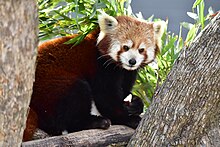Seneca Park Zoo
| Seneca Park Zoo | |
|---|---|
 Entrance to Seneca Park Zoo | |
 | |
| 43°12′23″N 77°37′26″W / 43.2065°N 77.6238°W | |
| Date opened | 1894[1] |
| Location | Rochester, New York, United States |
| Land area | 20 acres (8.1 ha)[2] |
| Annual visitors | 335,663 (2015)[3] |
| Memberships | AZA[4] |
| Major exhibits | Animals of the Savanna, A Step into Africa, Cold Asia, Genesee Trail, Rocky Coasts |
| Website | senecaparkzoo |
Seneca Park Zoo is a 20-acre (6.3 ha) zoo located in the city of Rochester, New York, US. The zoo is home to over 90 species including mammals, reptiles, birds, amphibians, fish, and arachnids. It is accredited by the Association of Zoos and Aquariums (AZA). The zoo is operated by Monroe County, with support from the Seneca Park Zoo Society. The zoo opened in 1894 in Seneca Park.
History
Seneca Park, designed by Frederick Law Olmsted, is located on the border of the City of Rochester and the Town of Irondequoit, along the Genesee River. The park was opened in 1893, and animals started being displayed in 1894. The first major addition to the zoo was the Main Zoo Building in 1931. The building was home to a wide variety of animals.[1]
The Seneca Park Zoo Society was chartered as an educational institution by New York State in 1957. Since that time, the Society has evolved into a non-profit organization that supports and promotes the zoo by running educational programs, special events, marketing and public relations efforts, fundraising for in situ wildlife conservation, and food and gift operations. The Society offers memberships that are very popular with area families.[1]
In 1975, a polar bear grotto was opened to house the zoo's two polar bears (Penny and Nickels), who had been acquired using pennies and nickels collected by local school children. In 1993, the zoo opened the $2 million Genesee Trail and Discovery Center—its first landscape immersion exhibit. This was followed in 1997 by the $8.2 million Rocky Coasts exhibit.[1]
On May 17, 2012, the zoo opened A Step Into Africa, which was designed to replicate a portion of the

In 2018, the zoo began making arrangements to demolish the Main Zoo Building as it no longer meets today's standards of animal welfare. On June 2, the zoo opened a Cold Asia portion, featuring a new exhibit for the zoo's snow leopards and bringing in red pandas. During that same year, an extension of A Step Into Africa opened with a new home for the resident southern white rhinoceros, and will feature new animals like Masai giraffes, plains zebras, ostriches, naked mole-rats, rock hyraxes, Lake Malawi cichlids, and many more.[6]
Exhibits
The Rocky Coasts exhibit opened in 1997. It is an area dedicated to animals of the polar and temperate coastal regions of the world, including African penguins, California sea lions, snowy owls, Canada lynx, and sandhill cranes. The exhibit includes an underwater viewing area which places visitors close to the sea lions swimming behind large glass windows.

A Step Into Africa was unveiled in 2012 and the exhibit includes a replica Maasai hut, Dig Zone for uncovering casts of fossils, interactive learning tools, and a stationary safari bus from which the zoo's African lions can be viewed. The area is home to the zoo's African bush elephants, olive baboons, and (Southern) African lions in naturalistic settings. Seneca Park Zoo is home to the first three African bush elephants in New York State.[7]
The zoo's animal collection changes periodically with AZA recommendations regarding breeding through the
Education and conservation


Seneca Park Zoo reaches out to many communities in the
Events

Seneca Park Zoo hosts many events throughout the year including free-with-admission events such as conservation education days and daily 'Summer Experiences' from Memorial Day Weekend through Labor Day. Popular fundraisers include ZooBrew, Zoobilation (annual gala), ZooBoo (Halloween), and Breakfast with Santa. The Jungle Jog
References
- ^ a b c d "Seneca Park Zoo". monroecounty.gov. Monroe County Government. Retrieved May 15, 2012.
- ^ "2015 Strategic Plan + Master Plan Update" (PDF). MonroeCounty.gov. Retrieved 29 March 2017.
- ^ "Annual Report 2015" (PDF). Seneca Park Zoo. Seneca Park Zoo Society. Retrieved 29 March 2017.
- ^ "Currently Accredited Zoos and Aquariums". aza.org. AZA. Retrieved August 4, 2011.
- ^
"Additional parking for weekend visitors at Seneca Park Zoo". Archived from the original on 9 February 2013. Retrieved 2012-05-15.
{{cite web}}: CS1 maint: bot: original URL status unknown (link) - ^ "Wilder Vision". Seneca Park Zoo.
- ^ Olson, Deborah. "North American Region Studbook for the African Elephant, 2011 Edition" (PDF). elephanttag.org. International Elephant Foundation. Retrieved 29 March 2017.

